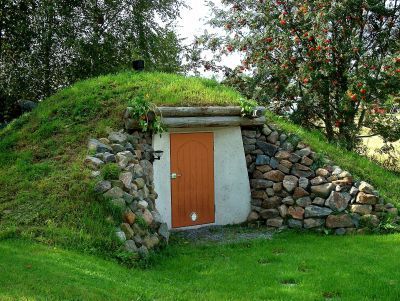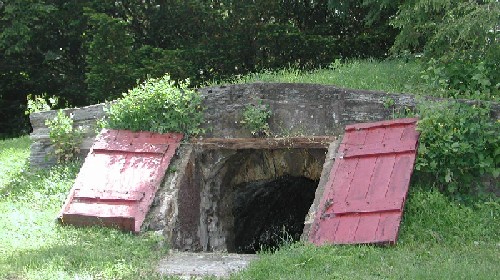The Underground Food Bank
- Whispering Wind Ranches
- Jun 16, 2023
- 4 min read
A root cellar is a cool, dark, and humid storage area for fruits, vegetables, and other perishable foods. It is typically built underground or partially underground, and it uses the earth's natural temperature and humidity to keep food fresh for extended periods of time.
Root cellars are a great way to extend the shelf life of your homegrown produce, and they can also be a great way to save money on food. Root cellars are particularly well-suited for storing root vegetables, such as potatoes, carrots, and beets, but they can also be used to store other types of fruits and vegetables, as well as canned goods and other food items.
If you are interested in building a root cellar, there are many different designs and plans available online. You can also hire a contractor to build a root cellar for you.
Here are some of the benefits of using a root cellar:
Extends the shelf life of food: Root cellars can help you to keep food fresh for up to several months.
Saves money on food: By storing your own food, you can save money on groceries.
Increases self-sufficiency: Having a root cellar can help you to become more self-sufficient and reduce your reliance on the grocery store.
Provides a sense of security: Knowing that you have a store of food on hand can provide peace of mind during times of emergency.
If you are considering building a root cellar, there are a few things you need to keep in mind:
Location: The ideal location for a root cellar is on the north side of your house, where it will be shaded from the sun.
Size: The size of your root cellar will depend on how much food you want to store.
Construction: Root cellars can be made from a variety of materials, including concrete, stone, wood, and brick.
Ventilation: Root cellars need to be well-ventilated to prevent mold and rot.
Security: Root cellars should be secure to prevent rodents and other pests from accessing your food.
There are many different types of root cellars, each with its own advantages and disadvantages. Here are a few of the most common types:
Barrel root cellars: These are the simplest type of root cellar. They are made by burying a barrel in the ground. This type of root cellar is not very large, but it is a good option for storing small amounts of produce.
Traditional root cellars: These are purpose-built structures that are dug into the ground. They are typically lined with stone or concrete to help regulate the temperature and humidity. Traditional root cellars can be large or small, and they can be built in a variety of shapes and sizes.
Hill root cellars: These are built into the side of a hill. They are similar to traditional root cellars, but they are easier to build because the ground is already excavated.
Under-structure root cellars: These are built under a shed or other structure. This type of root cellar is not as cold as a traditional root cellar, but it is still a good option for storing produce.
Above-ground root cellars: These are not actually cellars at all. They are insulated boxes or sheds that are used to store produce. Above-ground root cellars are not as cold as traditional root cellars, but they are a good option for people who do not have access to a basement or other underground space.
The best type of root cellar for you will depend on your needs and your budget. If you need a large root cellar, a traditional root cellar is a good option. If you need a small root cellar, a barrel root cellar or an above-ground root cellar may be a better choice.
No matter what type of root cellar you choose, it is important to keep the following things in mind:
With proper care, a root cellar can be a great way to extend the life of your homegrown produce. Here are some tips for proper care of a root cellar:
Keep the temperature cool. The ideal temperature for a root cellar is between 32 and 40 degrees Fahrenheit. If the temperature gets too warm, your food will spoil. If the temperature gets too cold, your food will freeze.
Keep the humidity high. The ideal humidity level for a root cellar is between 60 and 80%. If the humidity is too low, your food will dry out. If the humidity is too high, your food will mold.
Provide adequate ventilation. Root cellars need to be well-ventilated to prevent mold and rot. You can do this by installing vents in the walls and/or ceiling.
Keep the root cellar clean. Regularly clean and disinfect the root cellar to prevent the spread of pests and diseases.
Inspect the food regularly. Inspect the food in your root cellar regularly for signs of spoilage. If you see any signs of spoilage, discard the food immediately.
By following these tips, you can help to ensure that your root cellar is a safe and effective way to store food. Here are some additional tips for caring for a root cellar:
Check the temperature and humidity levels regularly. The temperature and humidity levels in your root cellar may fluctuate, so it is important to check them regularly. If the temperature or humidity levels are outside of the ideal range, take steps to correct them.
Clean and disinfect the root cellar regularly. As mentioned above, regular cleaning and disinfection will help to prevent the spread of pests and diseases.
Inspect the food regularly. Regular inspection of the food in your root cellar will help you to identify any signs of spoilage early on. Keep a log and rotate out items stored in your root cellar. Be sure to check the seals on any canned good you have stored, and keep all items clearly labeled with expiration dates. I personally keep a complete inventory on a spread sheet.
Repair any damage to the root cellar promptly. If the root cellar is damaged, it may not be able to provide the proper environment for storing food. Repair any damage promptly to prevent spoilage.
With proper care, your root cellar can be a valuable asset for storing food for months at a time.













